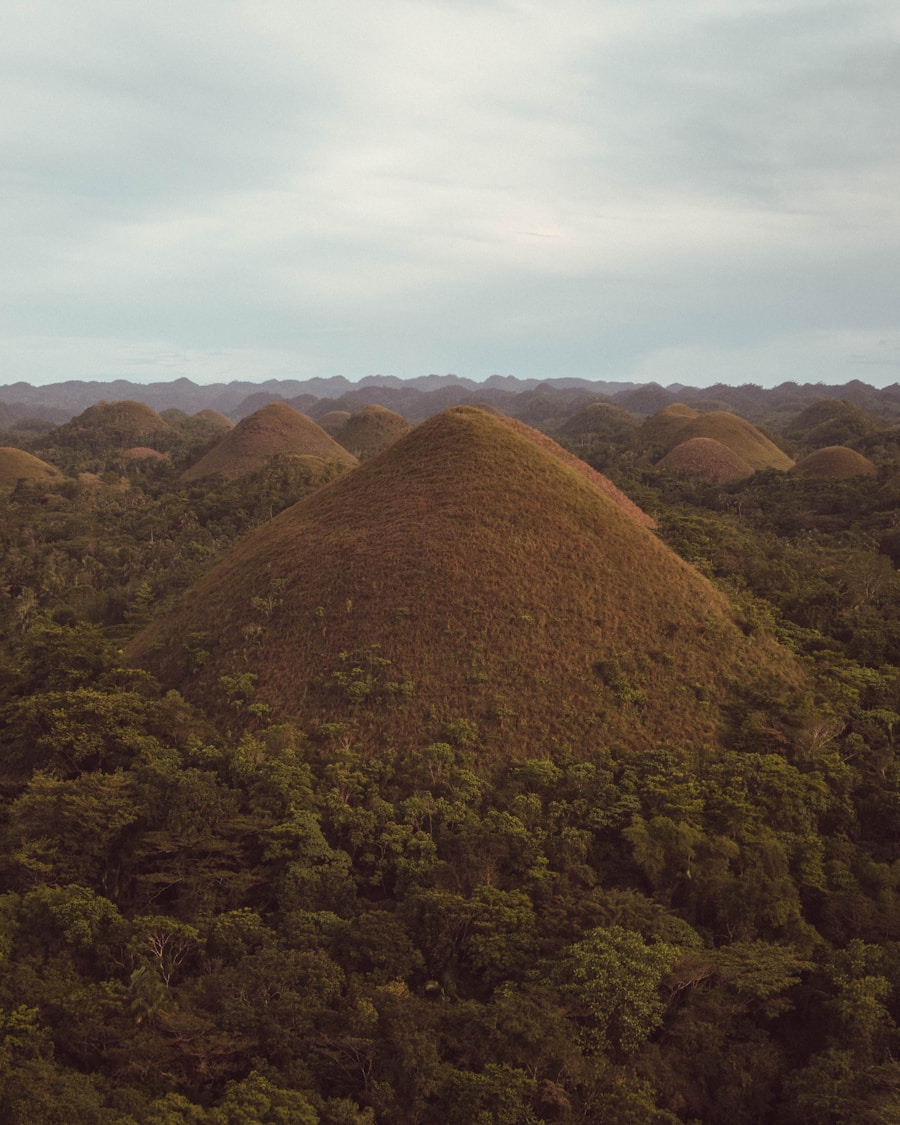Download links
How to install Discovering the Majestic Chocolate Hills APK?
1. Tap the downloaded Discovering the Majestic Chocolate Hills APK file.
2. Touch install.
3. Follow the steps on the screen.
Description
The Chocolate Hills, a geological wonder located in the Bohol province of the Philippines, are a striking natural phenomenon that has intrigued scientists and tourists alike. These hills, numbering over 1,200, are characterized by their conical shapes and uniformity, rising dramatically from the surrounding landscape. The formation of these hills is attributed to a combination of geological processes that took place over millions of years.
Primarily, they are composed of limestone, which was formed from the remains of marine organisms that settled on the ocean floor during the Pleistocene epoch. As tectonic activity lifted the seabed above sea level, erosion began to sculpt the landscape, creating the distinctive hills we see today. The process of erosion played a crucial role in shaping the Chocolate Hills.
Rainwater, along with the natural elements of wind and temperature fluctuations, gradually wore away the softer materials surrounding the limestone formations. This relentless erosion exposed the hard limestone core, resulting in the creation of the hills’ unique shapes. Interestingly, the hills are not volcanic in origin; rather, they are a product of karst topography, which is characterized by features such as sinkholes and underground rivers.
The Chocolate Hills’ formation is a testament to the dynamic forces of nature and serves as a reminder of the Earth’s ever-changing landscape.
Key Takeaways
- The Chocolate Hills were formed by the uplift of coral deposits and the action of rainwater and erosion over millions of years.
- Visitors can enjoy panoramic views of the Chocolate Hills from viewing decks and hillsides, offering breathtaking vistas of the unique landscape.
- According to local legend, the Chocolate Hills were formed from the tears of a giant who fell in love with a mortal woman and wept until the hills formed.
- The Chocolate Hills are home to a variety of plant and animal species, including the endangered tarsier and a diverse range of flora.
- In addition to exploring the Chocolate Hills, visitors can also enjoy activities such as ziplining, ATV rides, and visiting nearby attractions like the Tarsier Conservation Area.
- When visiting the Chocolate Hills, it’s recommended to bring sunscreen, water, and comfortable walking shoes, and to be mindful of the environment by not littering and respecting the local culture and customs.
Exploring the Chocolate Hills’ Breathtaking Views
Panoramic Vistas and Dramatic Landscapes
From various vantage points, such as the viewing deck at the Chocolate Hills Complex, tourists can take in panoramic vistas that stretch for miles. The sight of these perfectly symmetrical hills dotting the landscape creates an almost surreal experience, as if one has stepped into a painting.
Optimal Viewing Times and Photography Opportunities
The best time to visit for optimal views is during sunrise or sunset when the light casts dramatic shadows across the hills, enhancing their contours and creating a magical atmosphere. Photographers flock to this location to capture the ethereal beauty of the landscape, with many seeking to immortalize their experiences through stunning imagery.
A Nature Lover’s Paradise
The undulating hills, set against a backdrop of lush greenery and clear blue skies, provide an idyllic setting for nature lovers and adventure seekers alike.
The Legend and Folklore Surrounding the Chocolate Hills

The Chocolate Hills are steeped in local legend and folklore, adding an enchanting layer to their already captivating presence. One popular tale tells of two giants who engaged in a fierce battle over a beautiful maiden. In their rage, they hurled boulders at each other, creating chaos across the land.
After their fight ended, they left behind the scattered boulders that eventually transformed into the hills we see today. This story not only explains the hills’ origin but also reflects the rich cultural heritage of the Boholano people. Another legend speaks of a giant named Arogo who fell in love with a mortal woman named Aloya.
When Aloya passed away, Arogo was heartbroken and wept for days. His tears formed into hills as they fell to the ground, creating the Chocolate Hills as a monument to his lost love. Such stories highlight the deep connection between the local community and their natural surroundings, illustrating how folklore can shape perceptions of landscapes.
These legends are often shared with visitors, enriching their experience and providing insight into the cultural significance of this remarkable site. For more information on the cultural significance of folklore, you can visit UNESCO’s page on folklore.
The Flora and Fauna of the Chocolate Hills
| Category | Metrics |
|---|---|
| Flora | Over 1,200 plant species |
| Fauna | Various species of birds, mammals, and reptiles |
| Endemic Species | Several endemic species found only in the Chocolate Hills region |
| Conservation | Ongoing efforts to protect and preserve the unique flora and fauna of the area |
The biodiversity surrounding the Chocolate Hills is as remarkable as their geological features. The area is home to a variety of flora and fauna that thrive in this unique environment. The hills are primarily covered with grasslands, which turn brown during the dry season but burst into vibrant green during the rainy months.
This seasonal transformation supports various plant species that have adapted to thrive in this karst landscape. Among these are endemic species that can only be found in this region, showcasing nature’s ability to evolve in response to specific environmental conditions. In addition to its plant life, the Chocolate Hills are also a habitat for diverse wildlife.
Birdwatchers can spot numerous avian species soaring above or nesting in the trees that dot the landscape. The area is known for its rich birdlife, including species such as the Philippine tarsier—a small primate that is one of the world’s smallest mammals. These nocturnal creatures are often found in nearby forests and are a significant draw for ecotourists seeking to observe them in their natural habitat.
The interplay between flora and fauna within this unique ecosystem highlights the importance of conservation efforts to protect these natural treasures for future generations.
Activities and Attractions in the Surrounding Area
Beyond simply marveling at the Chocolate Hills themselves, visitors can engage in a variety of activities and attractions in the surrounding area that enhance their experience. One popular option is to explore nearby caves, such as the Hinagdanan Cave or the Danao Adventure Park, which offers thrilling activities like zip-lining and bungee jumping for adrenaline seekers. These attractions provide an opportunity for adventure while allowing visitors to appreciate Bohol’s stunning natural beauty from different perspectives.
Additionally, cultural experiences abound in Bohol. Tourists can visit local villages to learn about traditional crafts such as weaving or pottery-making. Engaging with local artisans provides insight into Boholano culture and traditions while supporting sustainable tourism practices.
For those interested in history, visiting historical sites like Baclayon Church or Blood Compact Shrine offers a glimpse into Bohol’s rich past and its significance in Philippine history. These activities complement a visit to the Chocolate Hills by providing a well-rounded experience that showcases both nature and culture.
Tips for Visiting the Chocolate Hills
When planning a visit to the Chocolate Hills, there are several tips that can enhance your experience and ensure a smooth trip. First and foremost, consider timing your visit during the dry season from November to May when visibility is at its best and the hills exhibit their iconic chocolate color. Arriving early in the morning or later in the afternoon can help you avoid crowds and provide optimal lighting for photography.
It’s also advisable to wear comfortable clothing and sturdy footwear if you plan on hiking or exploring nearby trails. The terrain can be uneven, so being prepared will allow you to fully enjoy your adventure without discomfort. Additionally, bringing along water and snacks is essential, especially if you plan on spending several hours exploring the area.
Lastly, consider hiring a local guide who can provide valuable insights into both the geological features and cultural significance of the Chocolate Hills, enriching your understanding of this extraordinary destination. In conclusion, visiting the Chocolate Hills offers an unforgettable experience filled with natural beauty, cultural richness, and thrilling adventures. By understanding their formation, exploring their breathtaking views, delving into local legends, appreciating their biodiversity, engaging with surrounding attractions, and following practical tips for your visit, you can create lasting memories at this iconic Philippine landmark.
FAQs
What are the Chocolate Hills?
The Chocolate Hills are a geological formation in the Bohol province of the Philippines. They are made up of around 1,268 cone-shaped hills, which are covered in green grass that turns brown during the dry season, giving them the appearance of chocolate kisses.
How were the Chocolate Hills formed?
The exact formation process of the Chocolate Hills is still a subject of debate among geologists. However, it is widely believed that they are the result of the uplift of coral deposits and the action of rainwater and erosion over millions of years.
What is the best time to visit the Chocolate Hills?
The best time to visit the Chocolate Hills is during the dry season, which typically runs from late November to May. This is when the grass covering the hills turns brown, giving them their chocolate-like appearance.
Are there any activities to do at the Chocolate Hills?
Visitors to the Chocolate Hills can enjoy activities such as hiking, bird watching, and taking in the panoramic views from the viewing deck. There are also ATV tours and zip lining available for those seeking a more adventurous experience.
Is there an entrance fee to visit the Chocolate Hills?
Yes, there is an entrance fee to visit the Chocolate Hills. The fee helps with the maintenance and preservation of the area.






